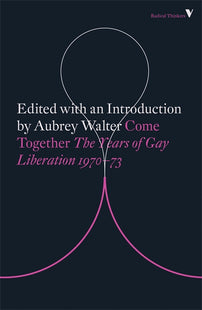Liberal Sex Education - More Subtle Oppression
How is sex taught in schools? How could it be taught? Isn’t there something rather odd about the whole idea? An excerpt from Come Together: The Years of Gay Liberation 1970-73 edited by Aubrey Walter

This extract comes from the the essay 'Liberal Sex Education - More Subtle Oppression' by Sarah and David, contributors to Come Together: The Years of Gay Liberation 1970-73, which tells the incredible story of the emerging radicalism of the Gay Liberation Front, providing a vivid history of the movement, as well as the new ideas and practices it gave rise to across the United Kingdom. Before marriage equality or military service, Come Together reminds us of paths forged but not taken by queer politics in its earliest stages.
Liberal Sex Education - More Subtle Oppression
How is sex taught in schools? How could it be taught? Isn’t there something rather odd about the whole idea?
Sexuality is a terrifically powerful force, one which needs to be controlled for ‘the good of society’. The easiest way to do this is to hive it off from the rest of life and confine it in a secure little niche of its own. School sex education is an extra means of doing this: treat sexuality like other school subjects, that is, separate it from everything else, confine it in the classroom and sterilise it for academic dissection. Make sex as boring and as remote from life as mathematics or geography and maybe the kids won’t have this ‘unhealthy obsession’ with sex we read about so much.
Quite apart from the cruel and selfish hypocrisy of teaching children about sex but coming down heavy on them if they dare put any of their knowledge into practice, this process of isolation kills off the very nature of sexuality, which is its comprehensiveness. Sexuality is like a substructure which affects everything and is affected by everything; to compartmentalise it would be to produce an obscene parody — certain physical activities with a few feelings thrown in to make it more ‘human’. In this society at the moment it is such a parody that passes as the true currency. And the sex education given in schools is bound to reflect and reinforce the sexual attitudes of the society in which schools work. In other words, sex confined within marriage, sex for the purpose of creating children, and to hold that family together, gender roles which condition women and men to think, feel and behave differently so that they can perform their different social functions properly (butch male goes off to work to prove his manhood, while submissive female stays at home to look after the children and give pleasure to her husband). So there isn’t much chance of our getting a fair treatment for homosexuality — which is a threat to all this — in schools. At best we can hope for a tolerance of us as a minority deviant group, if you can call that tolerance.
An alternative way of getting our ideas across to children, besides writing and distributing our own sex-education material, is to work with groups of schoolchildren who are themselves beginning to challenge the stupid reactionary ideology of the classrooom. The conference in Birmingham on sex education, to be held by the Schools Action Union on October 24th, is one very good starting-point here.
What about the existing sex-education literature? The National Secular Society pamphlet Sex Education, written by Maurice Hill and Michael Lloyd-Jones, hits out very hard at most of the forty-two sex-education texts that they review. They denounce the majority of these as obscurantist, anti-sex, moralistic, and vicious in their effects on children’s psychological development. Their romp through the absurdities and laughable nonsense given out in the name of education is great fun too. But they write from a liberal standpoint, and what is important for gay liberation is to discover the limitations of the liberal attitude and to go beyond it. We will therefore concentrate on the only books out of the forty-two reviewed which the National Secular Society recommend (and endorsed by The Little Red Schoolbook), W.B. Pomeroy’s Girls and Sex and Boys and Sex (both Penguin).
Gay people have been so trod on by Judeo-Christian morality for upwards of 2000 years that we tend to greet the ‘enlightened’ liberal attitudes expressed in books like Pomeroy’s with an audible sigh of relief. Pomeroy doesn’t treat homosexuality as a wicked perversion, and, unlike many of his more reactionary psychiatric colleagues, he doesn’t even treat us as sick. But this apparent tolerance is no more than skin deep. Beneath it, Pomeroy’s brand of liberalism is just as oppressive to gay people as the traditional bigotry he condemns. Because the psychiatrist sees individuals as the problem, not society. He accepts society as it is, and works to reintegrate the deviant individuals, whether he assumes that they are sick and in need of a cure, or whether he sees them simply as unhappy people who would be happier if they were like everyone else.
The underlying premise of everything Pomeroy says is that this is our society, we have to live in it, and there is nothing we can do to change it. From that starting-point, the tolerance that Pomeroy displays towards homosexuality must inevitably be subordinated to the task of propping up the family and the gender-role system which we, as homosexuals, threaten, and rescuing’ as many girls and boys as possible for the heterosexual way of life.
In the chapter on homosexuality in Girls and Sex, Pomeroy is, on the surface, accepting of lesbianism. But the overall impression one comes away with is that to be a homosexual is not quite right, that we’re rather sad people, deserving sympathy perhaps but certainly not to be encouraged.
The reason that Pomeroy is unable to accept homosexuality as an equal to heterosexuality is that the former is outside the framework of society (marriage and the family); it is a social maladjustment. And as we have said, Pomeroy’s basic standpoint is that society is the unchangeable ‘given’, beyond criticism, into which the individual must be made to fit. This point comes across very clearly at the end of the chapter:
Homosexual relationships can be as pleasurable, as deep and as worthwhile as relationships with males, but because our society is so orientated in the direction of heterosexuality and has such strong taboos against homosexuality, it seems to me that girls should think long and hard before rejecting sexual activity with boys in preference to girls.
It’s alright in itself, but in this society it’s not. The lesbian is ‘sentencing herself to live in the shadow of society’s disapproval’, she is ‘closing the door to marriage and children’. It would be truer to say that ‘she is sentenced’ and that ‘the door is closed to her’, but then if you take the liberal psychiatrist’s viewpoint you inevitably find yourself standing everything on its head. Only that way can you be the right way up.
It’s impossible to keep up the pretence that ‘it’s alright in itself but in society it’s not’, and in fact by various underhand means Pomeroy undercuts his ‘tolerance’ to give the impression that there is nothing good or positive in homosexuality. For example, there is the silence with which he greets the pleasures and delights of lesbian relationships, in contrast to the space he gives to explaining the so-called disadvantages. This imbalance creates a bias in the mind of the reader.
Then, he heavily stresses negative reasons for becoming a lesbian:
Perhaps, even worse, she is choosing this direction, or being forced into it, for the wrong reason, namely, because of a rejection of males rather than an acceptance of females.
There’s a point in this: a negative motivation is bad, although probably only when it’s strong enough to affect one’s relationships with women (after all, rejection of males is quite understandable in the present gender-role system — who wants to be fucked by someone who is just using you to prove his virility? — and an initial negative motivation can grow into a positive one). But Pomeroy is really making his point by stressing this possible negative side, playing down the positive, to imply that all lesbians are such because they are afraid of men. He — being a ‘he’ — cannot appreciate the fact that women can love women, without qualification.
Or again, he advises a girl who suspects that her boyfriend is a homosexual not to reject him because of it. Rejection would only push him ‘farther in the direction of homosexuality’. Why not, if there’s nothing wrong with homosexuality? But of course Pomeroy isn’t a ‘Right On!’ — he really doesn’t believe there’s nothing wrong, as this and the other passages make clear. Likewise, he says that the girl should try to establish a relationship with this poor kid so that ‘his homosexuality will fall into proper perspective in his life.’ This proper perspective is, we suppose, somewhere around vanishing-point. For Pomeroy’s underlying assumption is that homosexuality is incidental and irrelevant to the individual, somehow not to be taken seriously. He takes the absurd view that sexuality doesn’t exist, only sexual activities, which aren’t an integral part of the personality. And so, ‘lesbian’ or ‘homosexual’ — that is, someone defined in terms of her or his sexuality — are not real beings: ‘I believe people should be accepted or rejected on the basis of themselves as individuals, rather than whether they like ice cream or pie.’
[book-strip index="1" style="buy"]